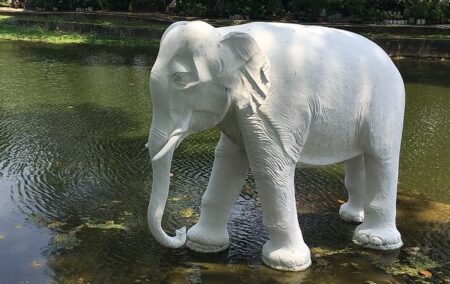In spite of its name – Xhosa for ‘home of the hippo’ – the Mzimvubu Project is a white elephant (originally a gift from the Thai king to someone he wished to ruin with the expense of looking after a sacred animal that could not be put to any practical purpose).
The project, announced in 2006 by then Eastern Cape Premier Nosimo Balindlela, was for 50 000 hectares of irrigation, 300 000 jobs, and the transfer of water to the Gariep for Northern Cape grape farmers.
In 2013, it was a priority in the State of the Nation Address (SONA) by President Jacob Zuma.
Two weeks ago, it was re-introduced in SONA by President Cyril Ramaphosa, with Minister of Human Settlements, Water & Sanitation Lindiwe Sisulu adding some new wrinkles. (Most white elephants develop these).
How to pay?
Little boys cannot resist playing with mud and water; when they grow up, some become engineers. Engineers cannot resist dam sites on big rivers. But how to pay for them? Fortunately, politicians cannot resist white elephants; so engineers and politicians get together.
By 2018, the white elephant had grown, as they always do, to R16 billion. But no-one knew how to pay for it – the Department of Water Affairs was bankrupt, and the Minister of Finance said no to more government loan guarantees. The solution was to get an international loan from China, which of course means Chinese construction, Chinese materials, Chinese jobs, (and also no tenders, no budgetary process, no parliamentary oversight – just a massive bill for the next generation.)
Then suddenly it was announced the Trans Caledon Tunnel Authority would do the job. Just as suddenly, they disappeared again. Big yellow machines have, likewise, been on site, and then disappeared.
Rural water supply, irrigation, hydropower, water for Gariep grape farmers in the Northern Cape, and water for Port Elizabeth were all part of the legend of this multi-purpose, integrated, forward-looking, regional development dream. Let’s touch briefly on each.
Rural water supply: 1 800 km of water supply pipeline (enough to bring water from the Limpopo!) and managed by Amatola Water would supply OR Tambo District Municipality with expensive bulk water which it could then sell to 726 600 indigent rural users. Much cheaper supply alternatives exist.
Perpetual government support
Irrigation: The 50 000 ha of irrigation is now only 2 450 ha, divided into sixty 40-ha commercial farms situated on communal land. The project analysis states the farms will need perpetual government support. Surely someone is joking? Have they never been to the Ncora, Qamata, Tyefu irrigation schemes?
Hydro-electric power: this is only planned to pump water to the non-viable irrigation farms. Nevertheless, Minister Sisulu said in Parliament: ‘Out of the hydro-power we produce we could get the whole of Eastern Cape out of the Eskom grid. That will be a great relief for Minister Mantashe.’ Quite how 37MW from the Ntabalenga Dam will replace the 4000MW the Eastern Cape uses she did not explain.
Mention of Gwede Mantashe reminds one to enquire whether the local communities have agreed, through the Interim Protection of Informal Land Rights Act, to the flooding of their land for the dam. The Xolobeni court judgment against Minister Mantashe suggests there may be a problem over land rights.
In order to avoid breaking the national record for the fastest silted dam, the 8 000 dongas in the catchment require social land-use management skills and community negotiations that engineers are not renowned for.
Pumping water over the berg for Port Elizabeth and the Northern Cape disappeared from the plan in face of the costs.
Cost to taxpayers
None of the individual components – water supply, irrigation and hydro-electricity – stand up to economic analysis, even in the Department of Water Affairs’ own documents.
The white elephant will need to be subsidized by government – that is, by you, the taxpayer – forever.
Let’s hope the planned majestic glass bridge over the Magwa Falls – part of the vision for fixing the ill-fated Magwa and Majola tea estates, which have cost taxpayers hundreds of millions of rand in the past 20 years – will take the weight of white elephants, as they seem to be breeding.
Perhaps, after all, we should stick to re-introducing hippos.
The views of the writer are not necessarily the views of the Daily Friend or the IRR
If you like what you have just read, become a Friend of the IRR if you aren’t already one by SMSing your name to 32823 or clicking here. Each SMS costs R1. Terms & Conditions Apply.

